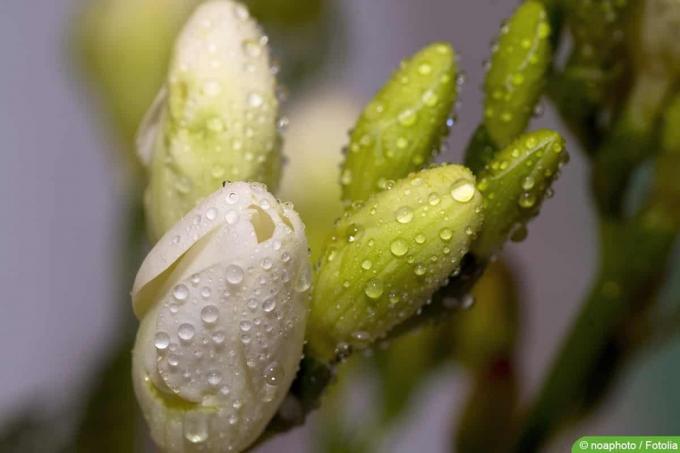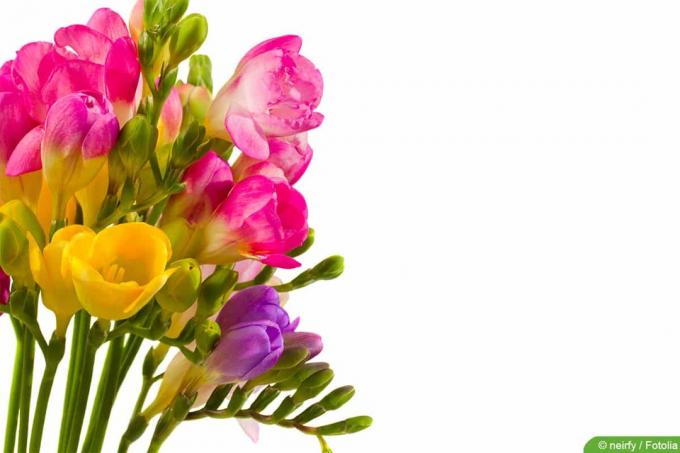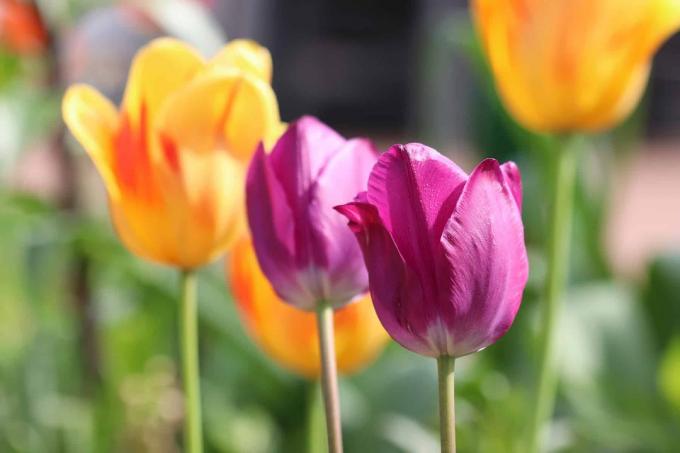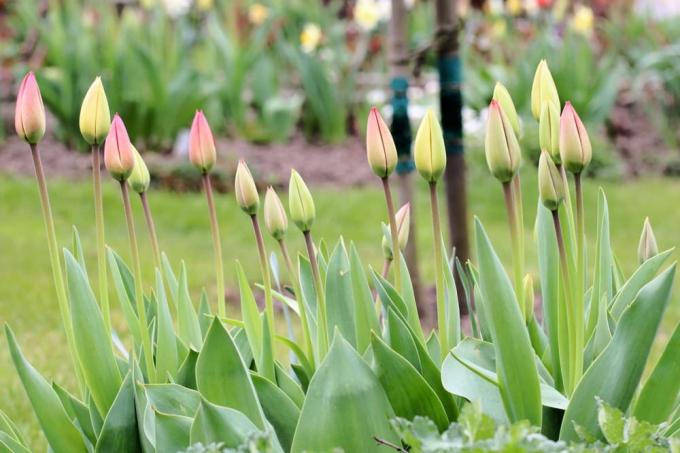

Table of contents
- Characteristics
- Location
- soil and substrate
- planting time
- planting
- Pour
- Fertilize
- pruning
- propagation
- Diseases
- pests
- wintering
The freesia is the ideal plant for garden beginners. It is not demanding in terms of care, it should only be watered regularly. Hobby gardeners are rewarded with lush flowering in late summer.
Characteristics
- Family: Irises (Iridaceae)
- Occurrence: Regions of Africa with winter precipitation
- Height: 25 - 40 cm, some varieties up to 100 cm
- Growth form: upright, narrow
- Leaves: green, narrow, erect
- Flower shape: funnel-shaped, slightly fragrant, up to 8 cm long
- Flowering period: August - October
- Flower colors: white, yellow, orange, red, violet, blue, multicolored
- Hardiness: not hardy
- Usage: bedding plant, potted plant, cut flower
Location
Freesia is a sun worshiper and thrives best when it gets as much light as possible. It thrives at most in semi-shady places, but is already less willing to bloom there. It also cannot withstand the blazing midday heat, provided it can compensate for the loss of moisture via the leaves by absorbing water via the roots. Permanently moist soil is therefore essential in full sun.
soil and substrate
If the freesia is planted outdoors, where it feels most comfortable, it is undemanding. Normal garden soil is usually sufficient for them to bloom beautifully. The pH of the substrate should be neutral to slightly alkaline. Freesia tolerates lime only to a limited extent.

If you want particularly richly flowering freesias, you should pay attention to the following soil properties:
- permeable
- humorous
- slightly damp
If you plant the freesia in a pot or trough, make sure that you mix the soil with substrate that can store water well and release it back into the environment. Lava granules or expanded clay, for example, are suitable for this.
A notice:
Although the Freesia likes it constantly damp, it does not appreciate waterlogging. Therefore, especially when cultivating in pots or tubs, make sure that the bottom layer is drainage made of expanded clay.
planting time
Freesias that have been advanced or are already in bloom are often offered in specialist shops. The bulbs are also sold in early spring and can be planted outdoors from mid-May. If you buy bulbs early, you should keep them in the dark and not too warm. Room temperature is usually too high.
Tip:
One to two weeks before you want to plant the bulbs, you should spray the bulbs with water or repeatedly bathe them briefly in lukewarm water. This can speed up budding after planting.
planting
Before you plant the freesia, loosen the soil deeply. This can be omitted if you prepare the soil or pot with fresh substrate. The bulbs are planted 5-10 cm deep. Make sure you give the freesia enough space. For smaller varieties, a distance of 10 cm is sufficient, varieties that can grow very large should be at least 20 - 30 cm away from the next plant.
Although freesias also work very well as solitary flowers, they look best when they are planted in colour-coordinated individual groups.
Pour
Drought quickly becomes a problem for the Freesia and she lets everything hang or droop. can even shed the flowers prematurely. Therefore, water the plants regularly, especially if it has not rained for a long time. Pot cultures may even need to be watered at least once a day.
The freesia does not appreciate temperature shock when watering. Therefore, do not use irrigation water directly from the tap, but use tempered water. You can either use rainwater collected in barrels or tap water into a Fill the watering can and leave it for several hours to allow it to adjust to the ambient temperature adjusts.
The ideal time for watering is in the morning or mid-morning. In the midday heat, you should not water the freesias, unless it is an acute emergency that the substrate is very dry and the plants are already hanging their heads.
Fertilize
Although the Freesia likes nutrient-rich soil, basic fertilization with organic slow-release fertilizer is sufficient. Mature compost is sufficient as an organic fertilizer, but you can also use commercial fertilizer pellets, which you work into the soil or mix into the substrate. As soon as the plants bloom, you can fertilize regularly with a focus on potash. This has a positive effect on the flowers and they last longer or longer. the plants bloom more profusely.
pruning
A pruning is usually not necessary with the freesia. It produces flowers continuously until the end of the season. However, you can remove faded flowers and cut back the remains so that they do not form seeds. The formation of seeds would cost her unnecessary strength, which would affect the ability of the plants to bloom.
Freesias are not poisonous to humans, so you don't need to take any safety precautions when removing flowers. The situation is somewhat different for dogs and cats, for which the plants are poisonous.

If you use the freesia as a cut flower, be sure to cut off the stem close to the ground. This saves the plant a lot of energy, as it does not have to take care of any flowering stalks.
propagation
The freesia forms spherical capsule fruits, provided the plants have been pollinated. The fruits contain brown seeds that are shiny. However, outside of their natural distribution areas, freesias rarely ripen. Due to the late flowering time from August, seed ripening is only possible if the plants are protected over the winter.
Instructions for propagation via seeds:
- Remove seed pods from fully dried flower stalks
- Leave seeds to dry for a few days
- Keep seeds dry
- Soak seeds for 24 hours in early spring
- sow the next day in a soil-sand mixture
It is easier to propagate via bulbs. You can find these in autumn when you dig up the freesias for overwintering directly at the mother tuber. After a few years, the mother tubers are no longer so keen on flowering and should generally be replaced by younger tubers.
You can recognize the brood tubers by the fact that they are hanging on the side of the mother tuber or have already come loose. However, it takes several years for the bulbous bulbs to produce the first flowers.
Diseases
Exotic plants like the freesia are often attacked by special plant diseases that they bring with them from their homeland. This includes the freesia mosaic virus. In general, the plants are susceptible to mosaic viruses. In addition to a special type that only affects this plant species, it can occasionally happen that the bean mosaic virus also occurs. However, this is far less of a problem than the specific Freesia Mosaic Virus, which causes leaves to turn brown and plants to produce deformed buds.
In both cases, the plants can usually no longer be helped. In the early stages, you can still try to cut back the plants generously, but if the infestation is too large, you should dispose of the freesia in the residual waste. This also applies if the plants are affected by blight. The plants then wilt and die within a short time.
In this case you should even remove the substrate generously. When cultivating in a pot or trough, you should sterilize the containers.

Both blight and gray mold occur when it is wet for a long time and leaves or buds grow. soil is constantly wet. Although the freesias like it constantly slightly damp, they do not tolerate too much moisture. In both cases, it is helpful to have drainage in the garden soil, which tends to waterlogging, and a sunny location so that the leaves can dry off.
pests
Aphids and voles are the main problem for Freesia. The aphids pose a double threat, as they are the main vectors for the mosaic virus.
In the event of an aphid infestation, you should act as follows:
- Dissolve 50 g of soft soap in 1 L of warm water
- Let the solution cool down
- generously spray affected plants
- repeat every two to three days
In addition, you should promote beneficial insects in your garden in the fight against aphids. Aphid larvae devour several hundred aphids a day and are therefore a valuable weapon against these harmful insects.
A problem with planting outdoors are voles for which the tubers are also not poisonous. Especially when the freesias just don't want to drift, they have often fallen victim to the voles. If there is a risk of voles in the garden, you should not plant the tubers without protection. There are special planting baskets that you can put the bulbs in that the voles can't chew through. The tubers are usually safe in them and these baskets have the advantage that you can simply lift the tubers out of the ground for overwintering.
wintering
If the temperatures get cooler again, then the freesia usually moves in by itself. You can easily overwinter them as a tuber in a cool and frost-free place, for example in the basement. In the field, the tubers usually freeze to death at just a few degrees below zero, because the plant is not hardy.
Instructions for wintering:
- Cut off the remains of flowers and leaves
- Carefully pull the tubers out of the ground
- Carefully remove soil
- Place tubers in a box filled with sand
- Spray tubers occasionally with water in winter
The tubers can be planted out again from mid-May. Growing in an unheated greenhouse is not recommended. Freesia is particularly susceptible to disease there, and because it is not hardy, late frosts, when even greenhouse temperatures drop sharply, can damage the plants.
 garden editorial
garden editorial I write about everything that interests me in my garden.
Learn more about flower bulbs

Tulips do not bloom and only put out leaves: what to do?
Tulips are among the most popular spring bloomers. They are therefore extremely common in domestic gardens. However, various causes can lead to the onion plants only developing leaves and no flowers. You can find out what to do in this case here.

Madonna lily, Lilium candidum: 9 care tips
Due to its growth height of more than one meter and the imposing white funnel-shaped flowers, the Madonna lily is one of the most impressive native bulbous plants. What to look out for when caring for this impressive flower is summarized in 9 clear care tips.

Daylilies, Hemerocallis: care from A – Z
Daylilies (Hemerocallis) are among the loveliest and most rewarding flowering perennials. Even if each individual blossom lasts only one day, countless new blossoms form again and again and decorate the garden for weeks. In addition, they are available in almost every color imaginable.

Milk Star, Ornithogalum: care from A to Z
The Orange Milk Star (Ornithogalum dubium) is a popular ornamental plant from the Cape Province. Because of its decorative flowers, it is often used as a cut flower in flower arrangements. The ornamental plants are undemanding, but should be cared for with caution due to their toxicity.

Checkered flower: care from A to Z | Instructions
The checkered flower (Fritillaria meleagris) attracts everyone's attention with its bell-shaped flowers. The reason for this is their striking pattern, which is strongly reminiscent of a chessboard. This striking check pattern shows the bulb flower in different shades.

The perfect time to plant tulips is in the fall
Planting the tulip bulbs is an exciting time before winter. Tulips need a cold stimulus to sprout in the coming season and be able to present their flowers. If the right planting time is observed, nothing stands in the way of flowering.



